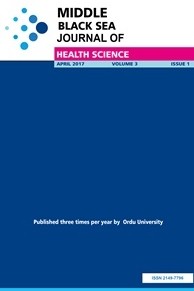The Efficacy of Tc-99m DMSA Scintigraphy in Children with Vesicoureteral Reflux Accompanying Frequent Urinary Tract Infection
Objective: Urinary tract infection is one of the most common diseases in childhood. Experimental studies have shown that renal damage due to urinary tract infection can be prevented by early diagnosis and treatment. The aim of this study was to evaluate the correlation between vesicoureteral reflux grade and Technetium-99m- dimercaptosuccinic acid scintigraphy in patients with frequent urinary tract infectionMethods Between January and October 2017, 34 cases were diagnosed as vescoureteral reflux with voiding cystoureterography were retrospectively evaluated with Technetium-99m- dimercaptosuccinic acid scintigraphy in terms of renal scar and function. Scars and function ratios were evaluated in Technetium-99m- dimercaptosuccinic acid scintigraphy according to voiding cystourethrography grades and correlation between the vesicoureteral reflux grade and Technetium-99m- dimercaptosuccinic acid scintigraphy findings were investigated.Results: Of 34 patients, 26 (76.5%) were female and 8 (23.5%) were male. The mean age of the patients was 6.08 ± 4.03 (min: 1 month, max: 17 years). Twenty-one patients had unilateral vesicoureteral reflux and 13 patients had bilateral vesicoureteral reflux. Vesicoureteral reflux were detected in 47 of the total 68 kidneys.Conclusion: In children with vesicoureteral reflux, Technetium-99m- dimercaptosuccinic acid scintigraphy provides useful information to show the kidney damage and as the vesicoureteral reflux grade increases, the rate of kidney damage increases. Even in the case of grade 1 and grade 2 vesicoureteral reflux, which are not expected to cause renal parenchymal damage. Technetium-99m- dimercaptosuccinic acid scintigraphy is the most successful imaging method for detecting parenchymal injury.
Keywords:
DMSA, Vesicoureteral Reflux, Voiding Cystoureterography,
___
- Agras K, Ortapamuk H, Naldoken S, Tuncel A, Atan A. Resolution of cortical lesions on serial renal scans in children with acute pyelonephritis. Pediatr Radiol. 2007 Feb;37(2):153-8.
- Awais M, Rehman A, Zaman MU, Nadeem N. Recurrent urinary tract infections in young children: role of DMSA scintigraphy in detecting vesicoureteric reflux. Pediatr Radiol. 2015 Jan;45(1):62-8.
- Bhatnagar V, Mitra D, Agarwala S, Kumar R, Patel C, Malhotra A, et al. The role of DMSA scans in evaluation of the correlation between urinary tract infection, vesicoureteric reflux, and renal scarring. Pediatric surgery international. 2002;18(2-3):128-34.
- Biggi A, Dardanelli L, Cussino P, Pomero G, Noello C, Sernia O, et al. Prognostic value of the acute DMSA scan in children with first urinary tract infection. Pediatric Nephrology. 2001;16(10):800-4.
- Camacho V, Estorch M, Fraga G, Mena E, Fuertes J, Hernandez M, et al. DMSA study performed during febrile urinary tract infection: a predictor of patient outcome? European journal of nuclear medicine and molecular imaging. 2004;31(6):862-6.
- Dogan CS, Koyun NS, Aksoy GK, Cekic B, Savas M, Comak E. Delayed diagnosis of primary vesicoureteral reflux in children with recurrent urinary tract infections: Diagnostic approach and renal outcomes. Turk J Urol. 2018 Nov;44(6):498-502.
- Hoberman A, Charron M, Hickey RW, Baskin M, Kearney DH, Wald ER. Imaging studies after a first febrile urinary tract infection in young children. New England Journal of Medicine. 2003;348(3):195-202.
- Hodson C, Maling T, McManamon PJ, Lewis M. The pathogenesis of reflux nephropathy (chronic atrophic pyelonephritis). The British journal of radiology. 1975:1-26.
- Peters CA, Skoog SJ, Arant BS, Copp HL, Elder JS, Hudson RG, et al., Snodgrass, W. T. Summary of the AUA guideline on management of primary vesicoureteral reflux in children. The Journal of urology. 2010; 184(3), 1134-1144.
- Piepsz A, Blaufox M, Gordon I, Granerus G, Majd M, O'reilly P, et al., editors. Consensus on renal cortical scintigraphy in children with urinary tract infection. Seminars in nuclear medicine; 1999: Elsevier.
- Piepsz A, Colarinha P, Gordon I, Hahn K , Olivier P , Roca I , et al. European Association of Nuclear Medicine. Guidelines on 99mTc-DMSA scintigraphy in children 2009 ;39: 156-73
- Roebuck D, Howard R, Metreweli C. How sensitive is ultrasound in the detection of renal scars? The British journal of radiology. 1999;72(856):345-8.
- Rushton HG. Urinary tract infections in children: epidemiology, evaluation, and management. Pediatric Clinics of North America. 1997;44(5):1133-69.
- Tekgul S, Riedmiller H, Hoebeke P, Kocvara R, Nijman RJ, Radmayr C., et al., EAU guidelines on vesicoureteral reflux in children. European urology, 2012; 62(3), 534-542.
- Stokland E, Hellstrom M, Jacobsson B, Sixt R. Imaging of renal scarring. Acta Paediatrica. 1999;88:13-21. Stokland E, Hellstrom M, Jacobsson B, Jodal U, Lundgren P, Sixt R. Early 99mTc dimercaptosuccinic acid (DMSA) scintigraphy in symptomatic first‐time urinary tract infection. Acta Paediatrica. 1996;85(4):430-6.
- Swerkersson S, Jodal U, Sixt R, Stokland E, Hansson S. Urinary tract infection in small children: the evolution of renal damage over time. Pediatr Nephrol. 2017 Oct;32(10):1907-1913.
- Simsek F, Ilker Y, Akdas A, Türkeri L. Teflon injection in the treatment of vesicoureteral reflux: a promising alternative for surgery. International urology and nephrology. 1991;23(1):27-30.
- Temiz Y, Tarcan T, Onol F, Alpay H, Şimşek F. The efficacy of Tc99m dimercaptosuccinic acid (Tc-DMSA) scintigraphy and ultrasonography in detecting renal scars in children with primary vesicoureteral reflux (VUR). International Urology and Nephrology. 2006;38(1):149-52.
- Wani KA, Ashraf M, Bhat JA, Parry NA, Shaheen L, Bhat SA. Paediatric Urinary Tract Infection: A Hospital Based Experience. J Clin Diagn Res. 2016 Oct;10(10):SC04-SC07.
- Wongbencharat K, Tongpenyai Y, Na-Rungsri K. Renal ultrasound and DMSA screening for high-grade vesicoureteral reflux. Pediatr Int. 2016 Mar;58(3):214-8.
- Yılmaz I, Peru H, Yılmaz FH, Sekmenli T, Ciftci İ, Kara F. Association of vesicoureteral reflux and renal scarring in urinary tract infections. Arch Argent Pediatr. 2018 Aug 1;116(4):e542-e547
- Yayın Aralığı: Yılda 4 Sayı
- Başlangıç: 2015
- Yayıncı: Ordu Üniversitesi
Sayıdaki Diğer Makaleler
Sevda ÖNDER, Havva ERDEM, Mürüvvet AKÇAY ÇELİK
Buğra ÇOŞKUN, Demet KOKANALI, Bora ÇOŞKUN, Burcu TİMUR, Ramazan Erda PAY, Ulaş FİDAN, Kazım Emre KARAŞAHİN
Tuğba Raika KIRAN, Onder OTLU, Ercan KARABULUT, Nermin OZCAN
Nihal ALTUNIŞIK, Sibel ALTUNIŞIK TOPLU, Serpil ŞENER
Damla TORUL, Çağla SUNAR, Havva ERDEM
Nülüfer ERBİL, Ulku KARAMAN, Erdal BENLİ, Deha Denizhan KESKİN, Abullah ÇIRAKOĞLU, Pınar GÜRGÖR, Cemil ÇOLAK
Esen SAYIN GÜLENSOY, Evrim Eylem AKPINAR
Mehmet Emin ÇELİKKAYA, Ahmet ATICI, Hasan İkbal ATILGAN
